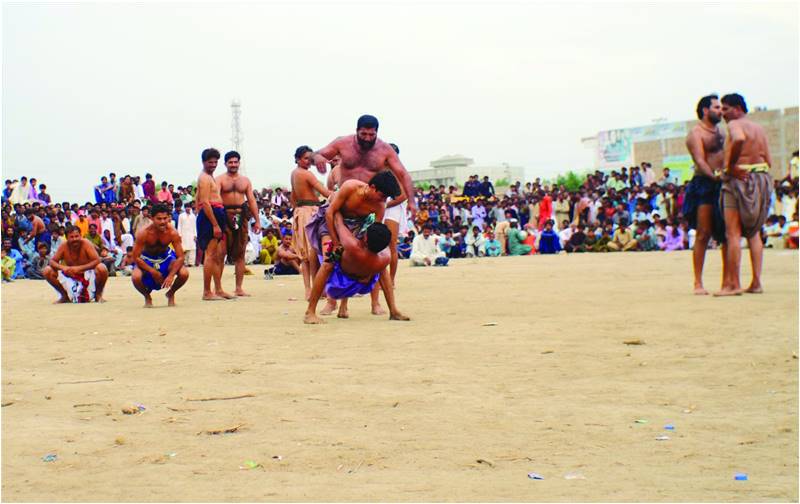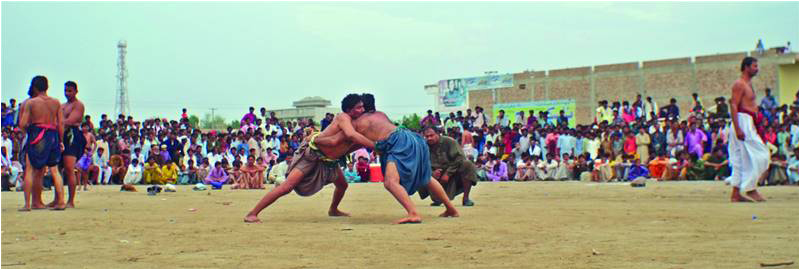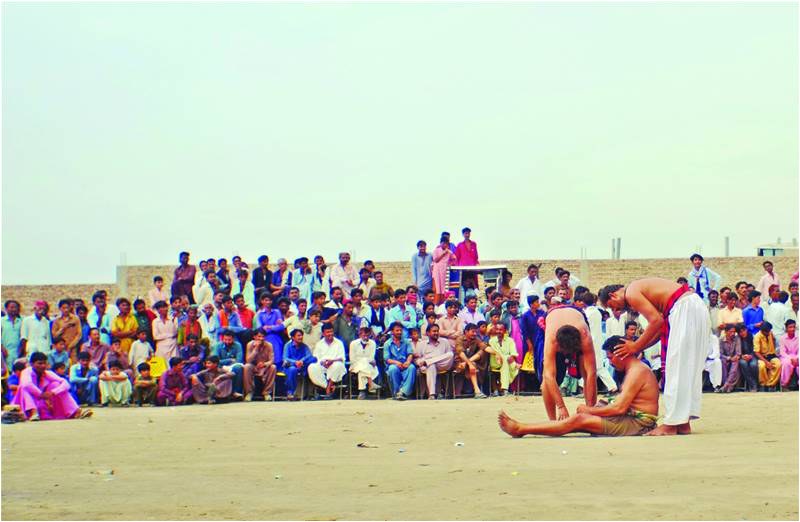
Malakhro is one of the oldest sport of the Indus Valley (modern-day Sindh) dating back perhaps 5,000 years or so. Today it is considered to be a Sindhi form of wrestling and is known as “Malh” in the Sindhi language, which translates as “wrestle”. There is much demand for watching this sport, predominantly amongst Sindhis living in Pakistan and India. There is a great number of offline followers for this form of wrestling, though it may be far less known in popular consciousness in Pakistan and the rest of the world. Avid followers of the sport are able to watch it at the annual Urs (celebration) of Shah Abdul Latif Bhitai at Bhit Shah and that of Qalandar Lal Shahbaz at Sehwan.
In Sindh’s rural population, Malakhro is a favourite sport of almost everybody regardless of caste, religion and socio-economic class. Malakhro is symbolic because it is a game based on a contest of force between two wrestlers. The power that it holds is also deeply rooted in the minds of the followers (spectators) of the sport – and the landlords or other local rich people sponsoring the game.

The sport is ruthlessly scary and painful in that it has no stage, stadium or specific arena. Malakhro, at its core, is an open-air real-time sport with no infrastructure made for it. All that it requires is a large flat stretch of earth. The arena has nothing to protect wrestlers: the surface of ground is as hard and tough as rock or concrete.
Malakhro is not simply a clash of brute force – as it might appear to be to the untrained eye at first glance. In fact, it has a competitive technical side to it. Techniques include the use of throws and take-downs. The audience is often able to predict the outcome of a bout by observing the techniques and skill levels of the rival competitors.
The technical aspect of Malakhro is accentuated by its specific set of rules: both opponents have to hold on to the twisted rope-like cloth tied to the waist of each wrestler. Letting go of the twisted cloth or rope means can result in a loss or penalty. Sometimes players take a break simply to re-establish their grip.
Pain, pride and joy are the intermingling emotions that the sport evokes in the competititors themselves. For instance, one who falls first on the ground with a push from their opponent loses the game and takes no pride, but only pain. Even before falling down, his fate is decided. Both the pain and joy in Malakhro are at extremes. When one loses, more often than not, that wrestler becomes unconscious and paralyzed for a good 5 to 10 minutes simply because of their brutal fall to the ground. When this happens, fellow wrestlers come to rescue the fallen/defeated competitor. They massage his head, feet or injured area. The game requires extensive practice of techniques, both defensive and offensive – much like in Western wrestling.

It is 5 pm when I reach the large ground near Mirpurkhas Bypass from Khipro city. The initial ceremonies for the day’s Malakhro contests have already begun. I am standing a the periphery of the arena. A massive colorful crowd is gathering – circling the arena and adjusting to find their spot, from where they can have a clear view.
The ground for the arena is arranged in a hierarchical way: the first row has chairs. Behind that the crowd stands to watch. And behind them, others in the crowd are watching from the top of their Toyota Daksan (local name used for a Toyota pick-up truck), tractor, jeep or even carts.
Many in the crowd cannot afford one of the chairs – they are charged fifty rupees per seat.
In comes the commentator and special guests who are seated oddly but in the semi-periphery of the wrestling arena.
I speak with a random person standing behind my chair and inquire about going further close to the centre where I can get good photographs and enjoy a view of game. I am told that I can go there – “It’s fine with me!”. But they could not cross these chairs and sit nearer to the core of the arena. At first, I wonder why they self-restricted themselves from the centre, while some other spectators clearly had no such restrictions. Then I understand that the restrictions were more for lower-caste Hindu spectators.
I move to the centre and sit beside young people who are watching the game enthusiastically – and with big smiles.
In most parts of urban Pakistan Malakhro is not a regularized sport because of its lesser popularity amongst mainstream sports, the media in general and urban people. Secondly, due to the non-regularized and traditional following of the sport, the wrestlers work very hard and risk their life with some difficult and strong opponents. The award in term of money comes from sponsors. More often than not, those are landlords or other local rich people. Most of the Malakhro wrestlers are into this game because of their difficult economic background and poor financial conditions. The passion comes later in the majority of cases.
I find that there is no support from the government: be it financial, technical or training to facilitate new upcoming wrestlers and keep engaged an older generation of players. The negation from the government and sports ministry suppresses the chances of the survival of Malakhro in Sindh particularly, and in Pakistan generally.
In Sindh’s rural population, Malakhro is a favourite sport of almost everybody regardless of caste, religion and socio-economic class. Malakhro is symbolic because it is a game based on a contest of force between two wrestlers. The power that it holds is also deeply rooted in the minds of the followers (spectators) of the sport – and the landlords or other local rich people sponsoring the game.

The sport is ruthlessly scary and painful in that it has no stage, stadium or specific arena. Malakhro, at its core, is an open-air real-time sport with no infrastructure made for it. All that it requires is a large flat stretch of earth. The arena has nothing to protect wrestlers: the surface of ground is as hard and tough as rock or concrete.
Malakhro is not simply a clash of brute force – as it might appear to be to the untrained eye at first glance. In fact, it has a competitive technical side to it. Techniques include the use of throws and take-downs. The audience is often able to predict the outcome of a bout by observing the techniques and skill levels of the rival competitors.
The technical aspect of Malakhro is accentuated by its specific set of rules: both opponents have to hold on to the twisted rope-like cloth tied to the waist of each wrestler. Letting go of the twisted cloth or rope means can result in a loss or penalty. Sometimes players take a break simply to re-establish their grip.
Pain, pride and joy are the intermingling emotions that the sport evokes in the competititors themselves. For instance, one who falls first on the ground with a push from their opponent loses the game and takes no pride, but only pain. Even before falling down, his fate is decided. Both the pain and joy in Malakhro are at extremes. When one loses, more often than not, that wrestler becomes unconscious and paralyzed for a good 5 to 10 minutes simply because of their brutal fall to the ground. When this happens, fellow wrestlers come to rescue the fallen/defeated competitor. They massage his head, feet or injured area. The game requires extensive practice of techniques, both defensive and offensive – much like in Western wrestling.

***
It is 5 pm when I reach the large ground near Mirpurkhas Bypass from Khipro city. The initial ceremonies for the day’s Malakhro contests have already begun. I am standing a the periphery of the arena. A massive colorful crowd is gathering – circling the arena and adjusting to find their spot, from where they can have a clear view.
The ground for the arena is arranged in a hierarchical way: the first row has chairs. Behind that the crowd stands to watch. And behind them, others in the crowd are watching from the top of their Toyota Daksan (local name used for a Toyota pick-up truck), tractor, jeep or even carts.
Many in the crowd cannot afford one of the chairs – they are charged fifty rupees per seat.
In comes the commentator and special guests who are seated oddly but in the semi-periphery of the wrestling arena.
I speak with a random person standing behind my chair and inquire about going further close to the centre where I can get good photographs and enjoy a view of game. I am told that I can go there – “It’s fine with me!”. But they could not cross these chairs and sit nearer to the core of the arena. At first, I wonder why they self-restricted themselves from the centre, while some other spectators clearly had no such restrictions. Then I understand that the restrictions were more for lower-caste Hindu spectators.
I move to the centre and sit beside young people who are watching the game enthusiastically – and with big smiles.
In most parts of urban Pakistan Malakhro is not a regularized sport because of its lesser popularity amongst mainstream sports, the media in general and urban people. Secondly, due to the non-regularized and traditional following of the sport, the wrestlers work very hard and risk their life with some difficult and strong opponents. The award in term of money comes from sponsors. More often than not, those are landlords or other local rich people. Most of the Malakhro wrestlers are into this game because of their difficult economic background and poor financial conditions. The passion comes later in the majority of cases.
I find that there is no support from the government: be it financial, technical or training to facilitate new upcoming wrestlers and keep engaged an older generation of players. The negation from the government and sports ministry suppresses the chances of the survival of Malakhro in Sindh particularly, and in Pakistan generally.

